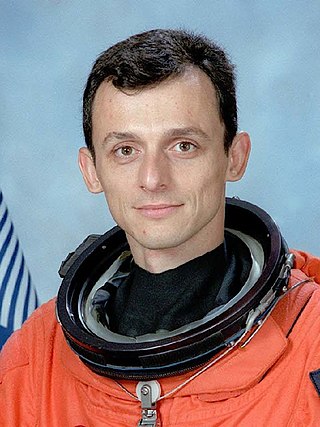
Pedro Francisco Duque Duque, OF, OMSE is a Spanish astronaut and aeronautics engineer who served as minister of Science from 2018 to 2021 and member of the Congress of Deputies, representing Alicante, from May 2019 until February 2020.
Hispasat is the operating company for a number of Spanish communications satellites that cover the Americas, Europe and North Africa from orbital positions 30.0° West and 61.0° West. It was formed in 1989 and its activities include provision of communication services in the commercial and government sectors. Hispasat's fleet of satellites broadcast more than 1250 television channels and radio stations to more than 30 million homes, as well as providing services such as broadband to mobile telephones and landlines.

Canal 24 Horas is a Spanish free-to-air television channel owned and operated by Televisión Española (TVE), the television division of state-owned public broadcaster Radiotelevisión Española (RTVE). It is the corporation's all-news television channel, and is known for its 24-hour rolling news service and its live coverage of breaking news.

PPS-1350 is a Hall-effect thruster, a kind of ion propulsion system for spacecraft. It was used in the SMART-1 mission to the moon and one geostationary satellites: Inmarsat-4A F4.
Hispasat 1C, also known as Hispasat 30W-3 and Hispasat 84W-1, was a Spanish communications satellite which was operated by Hispasat. It was constructed by Alcatel Space and is based on the Spacebus-3000B2 satellite bus. Launch occurred on 3 February 2000, at 23:30. The launch was contracted by ILS, and used an Atlas IIAS carrier rocket flying from SLC-36B at Cape Canaveral.
Deimos-1 is a Spanish Earth imaging satellite which is operated by Deimos Imaging who commercializes its imagery directly but also has distribution agreements with other entities like Astrium GEO and DMC International Imaging.
Amazonas 1 or Hispasat 55W-1 was a communications satellite based on the Eurostar 3000 satellite bus and owned by satellites operator Hispasat, based in Madrid, Spain. It was launched on 5 August 2004, with a launch mass of 4,5 ton, on a Proton-M Briz-M launcher to be located in the 61º W geostationary position.
Amazonas 3 is a communications satellite based on the SSL 1300 satellite bus and owned by the Hispasat Group of Madrid, Spain. It was launched by an Ariane 5 ECA launch vehicle on 7 February 2013, with a launch mass of 6265 kg. It will provide C-band and Ku-band service in Brazil for a joint venture of Hispasat and the Brazilian telecommunications carrier Oi.
Astra 5B is one of the Astra communications satellites owned and operated by SES. It was launched as SES' 56th satellite in March 2014, to the newest of the Astra orbital positions for direct-to-home (DTH) satellite television, at 31.5° East for DTH, DTT and cable use in Eastern Europe,.
INTELSAT 34 or IS-34 is communications satellite built on Space Systems/Loral's 1300-series satellite platform. The satellite broadcasts television to homes in Brazil, distributes video programming for companies like HBO and Fox across Latin America, and beams Internet broadband services to travelers aboard airplanes and ships crossing the North Atlantic Ocean.
Spainsat is a Spanish telecommunications satellite used for military and government communications. It allows telecommunications the different missions of the Spanish Armed forces abroad by providing coverage on a wide area of the world ranging from the United States and South America to the Middle East, including Africa and Europe.
Hisdesat is a Spanish company created in 2001 by Hispasat (43%), Ingeniería y Servicios Aeroespaciales (30%), EADS CASA, Indra Sistemas (7%) and SENER (5%) with initial investment of 415 million euros.

Hispasat 30W-6 is a Spanish communications satellite by Hispasat that launched on a Falcon 9 on March 6, 2018. It is replacing Hispasat 1D at 30° West longitude and will provide service for television, broadband, corporate networks and other telecommunications applications. The satellite features 4 × SPT-100 plasma propulsion engines.
The Amazonas 4A, renamed in 2016 Amazonas 4 and since 2017 known as the Hispasat 74W-1, is a Spanish commercial communications satellite developed by Orbital Sciences Corporation and operated by Hispasat. It was successfully launched in 2014 and it is expected to have a service life of 15 years however, shortly after its launch the satellite suffered a power failure that limited its operability and life.
The Hispasat 1B was a Spanish communications satellite operated by Hispasat. Along with the Hispasat 1A, the satellite covered communications over the American Continent for both civilian and military customers. Together they formed the first European constellation operating over the New World. Its service life ended in 2003.
The Hispasat 1D, since 2016 called Hispasat 30W-4 is a Spanish communications satellite launched in 2002 operated by Hispasat. Together with the Hispasat 1C it formed a constellation in order to strengthen communication ties between the American continent and the Iberian Peninsula for both governmental and private uses.
The Hispasat 1A was the first communications satellite operated by the Spanish company Hispasat. The satellite covered communications over the Atlantic Ocean for both civilian and military customers. Together with the later Hispasat 1B it formed the first European constellation operating over the New World. Its service life ended in 2003.



